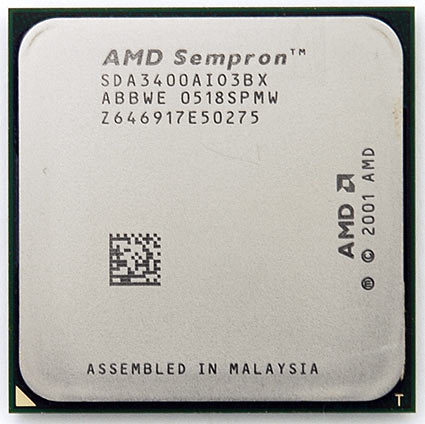A Dissatifying Compromise With AMD's 64 bit Sempron 3400+
AMD Sempron 64
The new chip is based on AMD's 90 nm Palermo core, and features a total of 256 kB L2 cache. The L2 cache size does not make that much of a difference, as you will see in our benchmark results, but it is widely used as a model differentiator among various AMD processor families. Clock speed is what primarily matters here.
Nothing has changed in term of the processor thermal design power (TDP): it is still 62 watts. However, we noticed slightly reduced core temperatures when compared to Semprons based on the 130 nm Paris core. The differences compared to the Oakville are, as one would expect, rather minimal.
The real news, besides the restoration of the larger cache memory, is the 64-bit AMD64 extensions. We suppose they are an integral part of AMD's current processor families and had been disabled - until today. Hence Sempron 64 users (3400+ only) can install Windows XP x64 edition, just as it has been possible with Athlon 64 and Pentium 4 600 series CPUs. However, more than a few gigabytes of RAM are unlikely to be supported by Socket 754 platforms anyway.
AMD's latest Sempron will be priced at $134 in quantities of 1,000, making it the most expensive budget CPU in AMD's portfolio. Thanks to its clock speed of 2 GHz, it should be on par with the Athlon 64 3000+ for Socket 939, running at 1.8 GHz and using AMD's dual channel DDR400 memory interface. This raises an interesting question though: wouldn't a cheap Socket 939 be the better solution?
The Socket 939 platform offers much better processor and motherboard variety, more features, and the better upgrade path we already mentioned. On the down side are cost considerations, which are of paramount importance to many customers. After all, if office applications are the primary purpose of the machine, it may not matter what system you use anyway - all of them are basically fast enough.
Get Tom's Hardware's best news and in-depth reviews, straight to your inbox.

Patrick Schmid was the editor-in-chief for Tom's Hardware from 2005 to 2006. He wrote numerous articles on a wide range of hardware topics, including storage, CPUs, and system builds.
